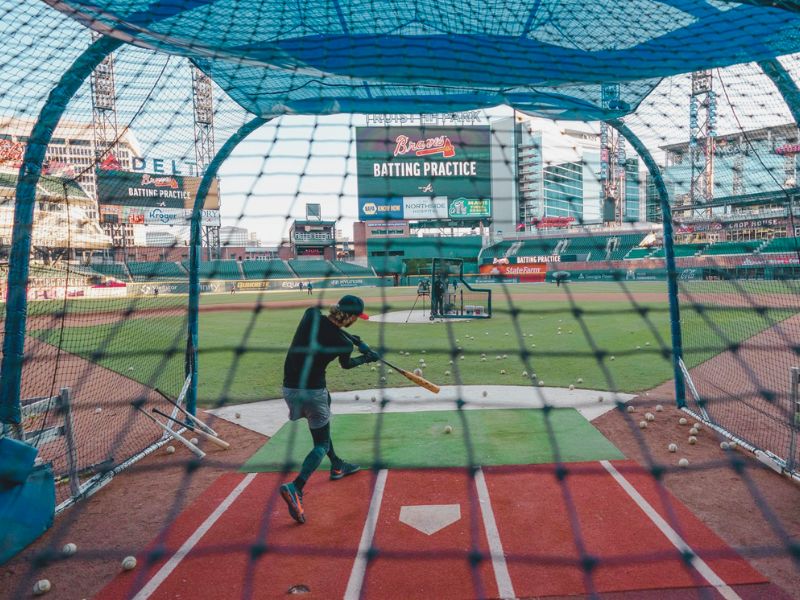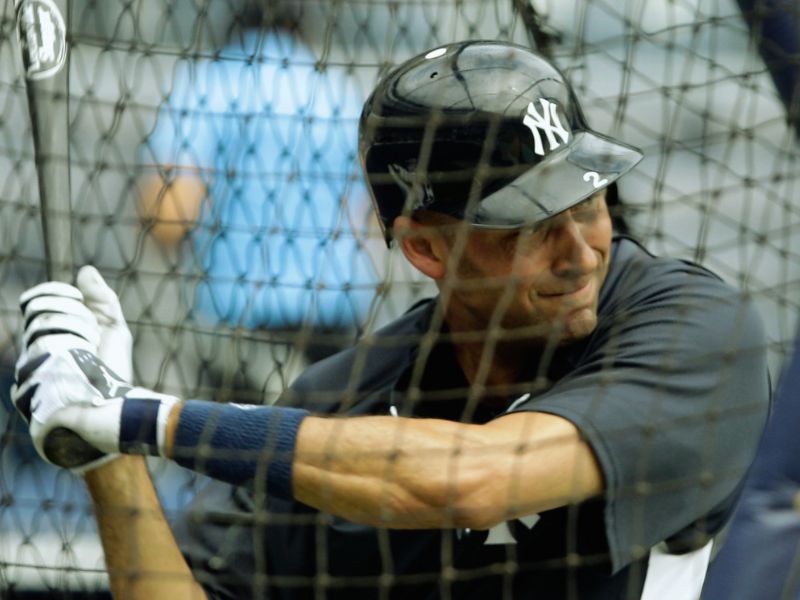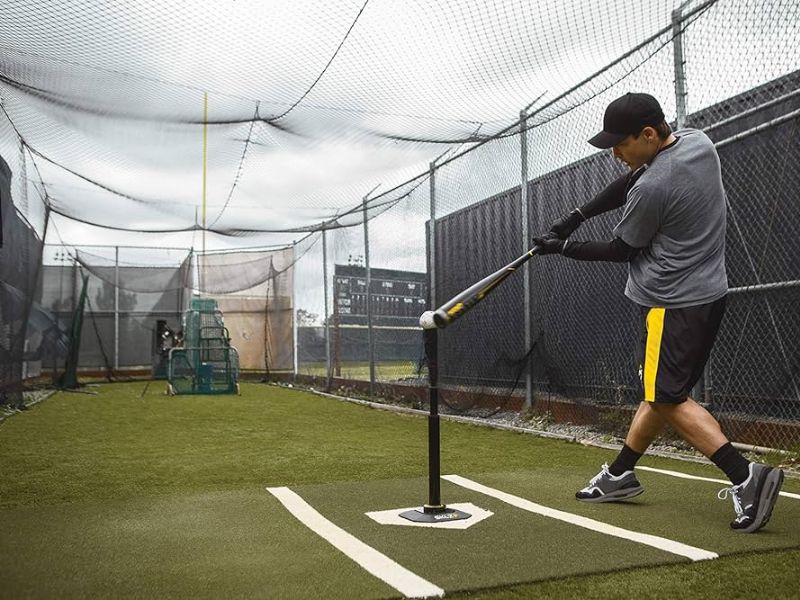If you’re a baseball enthusiast, I’m sure you’re familiar with the term BP. What does BP mean in baseball? And why do players often engage in it?
BP, short for Batting Practice, is a game training routine where players warm up by swinging pitched balls. However, its significance goes beyond that. It plays a role in the game. It can have a direct impact on a player’s performance.
During this practice session, players employ strategies to tune their bodies, sharpen their mental focus, and prepare themselves for the upcoming game. We’ll delve into the advantages of BP and even explore some approaches to traditional batting practice.
What Does BP Mean in Baseball
BP, short for Batting Practice, is a practice in baseball that players and teams engage in before games or training sessions. It’s an aspect of the sport at all levels, from the minor league to the major leagues.
The primary goal of BP is to enhance the hitting skills, timing, and confidence of batters while also warming up their muscles and preparing them for the game. BP also offers an opportunity for pitchers and fielders to refine their throwing and catching abilities.
During BP sessions, players step into the batter’s box, where they face a series of pitches delivered by either a coach or a pitching machine. Coaches also utilize BP as a means to assess their player’s strengths and weaknesses.

However, “BP” is also commonly used to refer to the Bullpen, which is the area where relief pitchers warm up during games and prepare to enter the game.
Both meanings of “BP” are integral to the game and are widely recognized by players, coaches, and fans. Understanding these two meanings will enhance your appreciation of how teams prepare for games and how pitchers and hitters work on their craft.
Fun Fact: The average MLB batter swings and misses at about 30% of the pitches they see in batting practice.
BP as Batting Practice
Batting Practice (BP) is an essential part of any baseball team’s routine, giving hitters the chance to fine-tune their swings before games and during training sessions.
Batting practice typically takes place before games, and it’s a time when players can work on their swing mechanics, timing, and overall hitting approach. Whether you’re in the major leagues or playing at an amateur level, BP helps players warm up and prepare for facing live pitching.
During batting practice, pitchers or coaches throw balls to hitters from behind a protective screen, allowing hitters to get consistent reps without the pressure of live game situations. BP can involve various drills, such as tee work, soft toss, and live batting, each aimed at improving different aspects of a player’s swing.
Batting practice isn’t just about warming up physically—it’s also about preparing mentally. Players get the chance to visualize success at the plate and work on hitting specific pitches or hitting to different parts of the field. Additionally, BP serves as a bonding experience for teammates, helping create a relaxed but focused atmosphere before the competition begins.
For fans attending a game, watching BP is part of the fun. It offers a unique chance to see players in a more relaxed setting, giving fans opportunities to catch home run balls and even interact with players. Teams usually allow fans to enter the stadium early to watch BP, making it a fan-favorite pre-game activity.
BP as Bullpen
While “BP” most commonly refers to Batting Practice, it can also mean Bullpen, an essential part of baseball where pitchers warm up before entering the game. The bullpen is located near the outfield, away from the dugout, and serves as a preparation zone for relief pitchers.
Relief pitchers use the bullpen to loosen up and get ready to enter the game in high-pressure situations, such as late innings when the team needs to hold onto a lead or come back from behind. The bullpen is often staffed by a bullpen coach, whose job is to monitor pitchers and ensure they are prepared for their role.
When “BP” is used in the context of the bullpen, it can be shorthand for the team’s relief pitching staff. These pitchers play a critical role, especially in modern baseball, where teams frequently rely on relievers to close out games or pitch in extra innings.
Equipment and Setup in BP in Baseball
Before you start batting practice, you’ll need some equipment and setup so the practice session is effective.
Pitchers or Pitching Machine
You can have the baseballs thrown at you by the coach or using a pitching machine. These machines are advanced pieces of equipment that can throw balls at varying speeds and even mimic different types of pitches like fastballs and curveballs.
A Batting Cage or a Net
Now, you’ll need a batting cage or a practice net to prevent the balls from flying away. This will help you focus on your swing and contact.
Baseballs and Bats
You have to ensure that there is a good supply of baseball. It might seem obvious but I have often seen teams run out of baseball in BP. Also, make sure all types of bats are there at the time of your practice session.
Safety Gears
Safety in BP is very important. Don’t forget protective gear like helmets for the hitters and L-screens for the pitcher or machine operator.
Did You Know: The balls that are used for batting practice are typically made of a softer material to lessen the chance of injuring players.
What are the Techniques and Strategies in BP in Baseball?
Hearing the term batting practice may seem like hitting the ball as hard as you can. But this is certainly not the case. Focusing on the techniques and strategies that make your Batting Practice so invaluable.
Pitch Recognition
One of the key elements in BP is pitch recognition. Players use this time to identify different types of pitches, like fastballs, curveballs, and sliders. The better you get at recognizing these, the more advanced your hitting game becomes.

Situational Hitting
This is your ability to adjust your approach and swing according to the game situation, such as the count, the score, and the inning.
You can use a pitching machine or a coach or a teammate to simulate different game situations and challenge you to hit accordingly.
Swing Mechanics
This is your ability to execute a proper and consistent swing that maximizes your power and accuracy. You can use a mirror, a video camera, or a coach to analyze and correct your swing mechanics.
You can use tees or hitting drills to isolate and focus on your swing and make adjustments to improve your contact and power.
Read More: What Is A Perfect Game In Baseball
What are the Benefits and Importance of BP?
Now you know that BP, or batting practice, is a vital part of baseball. But you may now question what are the benefits of it and if BP is really that important. Well, let’s find out the answer.
Hitting Skills
BP is the perfect platform for skill enhancement. It’s where players can work on pitch recognition, situational hitting, and swing mechanics. The more you practice, the better you get.
Team Strategy
BP isn’t just for individual players; it’s also a crucial time for coaches to assess team strategies. BP provides invaluable insights on whether it’s deciding the batting order or figuring out which player is best for specific game situations.
Physical and Mental Preparation
Before any big game, players need to be both physically and mentally prepared. BP is an excellent warm-up. By practicing with specific and relevant goals, players can prepare their minds and focus to perform at their best.

Fan Engagement
Yes, even fans benefit from BP! It’s a great time to watch your favorite players up close, understand their techniques, and maybe even catch a home run ball. Plus, it adds another layer of excitement and anticipation before the actual game begins.
What are the Alternatives to Traditional BP?
Traditional BP, or batting practice, is a common way for baseball players and teams to warm up and improve their hitting skills before a game or a training session. However, it’s not the only way to improve your game.
Virtual Reality Training
One of the cutting-edge alternatives to traditional BP you can opt for is the Virtual Reality (VR) training. This technology allows players to face virtual pitchers, offering a unique way to improve pitch recognition and decision-making skills.
Soft Toss and Tee Drills
Soft toss and tee drills are excellent alternatives to batting practice. Using a batting tee helps players focus on swing mechanics, making it easier to isolate and correct specific issues. Muhl balls are excellent in this drill.
However, repetitive tee work can also be tedious, repetitive, and unchallenging.

Machine Pitching with Variability
Pitching machines have come a long way. Modern machines can simulate different pitch types and speeds. Machine pitching with variability can be more realistic and challenging than traditional BP, as it can simulate various types of pitches.
It can also help you improve your pitch recognition, timing, and contact quality. However, machine pitching with variability can also be expensive, noisy, and hard to adjust.
Cage-Free Hitting
You can conduct cage-free hitting sessions in open fields. Cage-free hitting can be more fun and enjoyable than traditional BP, as it can give you more freedom and feedback on your hits.
However, cage-free hitting can also be risky. You need to have enough space and safety measures to prevent the balls from flying away or hitting other people or objects.
Fan Interaction During BP
For baseball fans, Batting Practice (BP) is not just a warm-up for the players—it’s also a unique experience and an exciting part of going to the ballpark. Many fans arrive early to games specifically to watch BP, where they can catch glimpses of their favorite players in a more casual setting. During batting practice, players often hit home runs and line drives, giving fans the chance to catch baseballs and take part in a memorable game-day experience.
Fans also use BP as a prime opportunity to get autographs and photos with players. Because BP takes place hours before the game, the atmosphere is usually more relaxed, and players are more likely to engage with fans, signing baseballs or other memorabilia. Kids especially love this aspect of the pre-game routine, as it brings them closer to the action and their favorite athletes.
For stadiums with large outfields, such as Coors Field or Dodger Stadium, BP becomes a home run catching paradise. Fans often bring their gloves and position themselves in the outfield seats, hoping to snag a BP home run ball. This interaction is one of the highlights of attending a live baseball game and helps create a connection between fans and the sport.
Frequently Asked Questions
1. What Does HBP Mean in Baseball
HBP stands for “Hit By Pitch” in baseball. It occurs when a batter is struck by a pitched ball without swinging at it. This usually results in the batter being awarded first base.
2. What Does B Mean in Baseball Pitching?
In baseball pitching, “B” typically stands for “Ball.” A ball is a pitch that is thrown outside the strike zone and that the batter does not swing at.
3. How Does MLB Batting Practice Work?
MLB Batting Practice (BP) is a structured session where players take turns hitting pitches. It serves as both a warm-up and a skill-building exercise, focusing on pitch recognition, situational hitting, and swing mechanics.
4. How Do You Run Batting Practice?
To run Batting Practice, you’ll need essential equipment like baseballs, bats, and a pitching machine or a coach to pitch. Players take turns hitting, focusing on various techniques and strategies like pitch recognition and situational hitting.
5. How Many Swings Are There in Batting Practice?
The number of swings in Batting Practice can vary, but players usually get around 30-50 swings. This allows them to work on different aspects of their hitting game, from swing mechanics to situational hitting.
6. Do MLB Teams Always Do Batting Practice?
No, MLB teams do not always conduct Batting Practice, especially during a long season. However, BP is a common practice, particularly before games, as it helps players warm up and refine their hitting skills.
Conclusion
I think now you have a clear idea of what does BP mean in baseball and why it is so important. BP serves as a multifaceted training ground for players. Though there is no hard and fast rule that BP is a must to conduct, conducting BP has several benefits.
I have discussed what equipment and setup you will need to conduct BP smoothly and what are the alternatives to BP. From now on, every time you hear BP, you know that it is more than just a warm-up.
You may also like
Major League Baseball Rain Delay Rules
What Is A No Hitter In Baseball?

Hello everyone. My name is Jason Butler, and I live in California, America. I was a professional AAA Minor League Baseball player. I lost my chance of playing MLB for injury issues, but I did not lose my love for baseball. I attended the coaching training program and am now working as a coach in a small school in San Diego.
I always love to share my experience and knowledge if that can help you. Play baseball, and stay fit.
